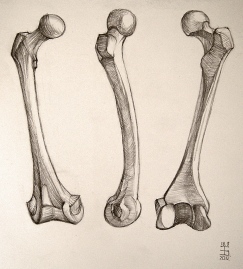By: Andrew Stewart Published 07/26/13
Hopefully after reading my last post you have some background on Vitamin D (If you’re still confused check out the links I included at the bottom of that post).
I think the next logical area I will cover is what researchers generally accept that Vitamin D does for you.
Like I mentioned earlier, Vitamin D does a ton of work within our bodies so this post is just going to scratch the surface.
Vitamin D, Calcium, and Phosphorus
 Under “normal operating conditions” Vitamin D increases the efficiency of the small intestine. Contrary to popular belief, the intestines actually are extremely important for getting the nutrients out of our food – more so than the stomach. Anyway, Vitamin D allows us to get more Calcium and Phosphorus from the food we eat and into our bloodstream (DeLuca 1988). Both Calcium and Phosphorus are essential in our bodies for a multitude of biological processes which contribute to its normal growth, development, and maintenance.
Under “normal operating conditions” Vitamin D increases the efficiency of the small intestine. Contrary to popular belief, the intestines actually are extremely important for getting the nutrients out of our food – more so than the stomach. Anyway, Vitamin D allows us to get more Calcium and Phosphorus from the food we eat and into our bloodstream (DeLuca 1988). Both Calcium and Phosphorus are essential in our bodies for a multitude of biological processes which contribute to its normal growth, development, and maintenance.
Increasing levels of Phosphorus and Calcium in our blood helps the body build and maintain stronger bones. If you are at risk for osteoporosis or perhaps have recently broken a bone getting adequate levels of Vitamin D in your diet can help you increase bone mass/healing. The majority of the research published in this area is in agreement – low levels of Vitamin D have been observed to result in a slightly increased risk of bone fracture (Scragg 2011).
Vitamin D and Muscles?
While most people associate Vitamin D with bone, did you know that it also acts on your muscles? Without going too in depth into skeletal muscle physiology Vitamin D helps move Calcium into muscle cells.
Once Calcium gets moved to the right area in your muscle cells it interacts with the small contractile proteins which work together to develop force in your muscles (via a process called the Cross-Bridge Cycle). Lower levels of Calcium in muscles reduce your ability to contract them which contributes to the feeling of fatigue (2002 Pfeifer et al.). While muscle weakness after a workout doesn’t necessarily mean that your Vitamin D is low, it may contribute in part to that long term fatigue experienced during those dark winter months.
Vitamin D Enemy of Bacteria
The final aspect of Vitamin D I will look at today is that of an Immune Booster within our bodies. The role of Vitamin D in the immune system was first considered after the discovery of Vitamin D receptors in many different types of immune cells within the human body. It now appears t hat Vitamin D induces anti-mycobacterial activity in certain immune cells that make up the first line of defense in our bodies against foreign invaders.
hat Vitamin D induces anti-mycobacterial activity in certain immune cells that make up the first line of defense in our bodies against foreign invaders.
Currently, it looks like Vitamin D modifies gene regulation causing a plethora of changes in these cells. The result is the production of strong bacteria eating macrophages (bacterial eating/killing cells) that are better at their job. Vitamin D allows the body to create cells that are both more effective at killing bacteria and are able to kill more bacteria before they run out of juice (2010 Baeke). When it comes to your immune system you definitely want it in tip top shape!
Now, in the media there has been quite a lot of buzz regarding Vitamin D and Cancer – I am saving this for last and will dedicate a whole post to the issue. You can look forward to this post within the next day or two. In the meantime, you can check out some of the literature I have cited below to get an in-depth view of the way Vitamin D works in our bodies.
References
Baeke, F., Takiishi, T., Korf, H., Gysemans, C., & Mathieu, C. (2010). Vitamin D: modulator of the immune system. Current Opinion in Pharmacology, 10(4), 482-496. doi: http://dx.doi.org/10.1016/j.coph.2010.04.001
DeLuca, H. F. (1988). The vitamin D story: a collaborative effort of basic science and clinical medicine. The FASEB Journal, 2(3), 224-236.
Pfeifer, M., Begerow, B., & Minne, H. W. (2002). Vitamin D and Muscle Function. Osteoporosis International, 13(3), 187-194. doi: 10.1007/s001980200012
Scragg, R. (2011). Vitamin D and public health: an overview of recent research on common diseases and mortality in adulthood. Public health nutrition, 14(9), 1515-1532.
Image: “Study of structure with pencil” by *monorok (©2012-2013)
Image: “Macrophage” dclaudiob (©2008-2013)